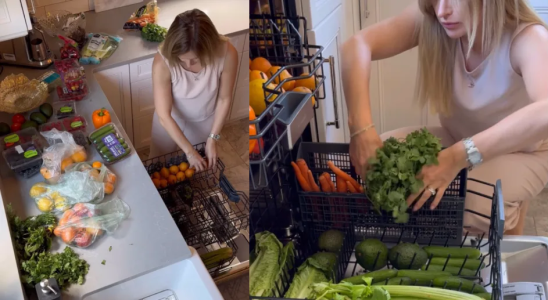You Won't Believe How This Woman Cleans Her Produce – Is It Genius or Just Gross?
By
Gian T
- Replies 28
In the age of life hacks and DIY solutions, it's not uncommon to come across some rather unusual methods for everyday tasks. But every so often, one pops up that truly divides the crowd. Enter the latest online debate: Is it innovative or just plain icky to clean your fruit and vegetables in the dishwasher?
Recently, lifestyle influencer Oksana Pali took to Instagram to share her 'reset regime' for washing her weekly produce. Instead of the traditional sink scrub, she opted for a more unconventional approach—loading her dishwasher with oranges, lemons, herbs, lettuce, avocados, capsicum, mandarins, apples, and cucumbers. The citrus fruits were nestled on the top shelf, herbs tucked into the cutlery tray, and lettuce laid out on the bottom shelf.
The internet's reaction? A mix of shock, curiosity, and a touch of admiration. 'Please tell me this is satire,' one user commented, voicing the collective concern over the potential for bacteria from previous wash cycles to linger and contaminate the food. Others were intrigued by the idea, with comments ranging from 'brilliant' to 'damn, that’s smart.'
Oksana defended her method, explaining that she uses a cold cycle with white vinegar and believes it saves water. She even hinted that this wasn't a spur-of-the-moment decision—she had read articles supporting the practice.
But before you start tossing your apples in with your plates, let's take a moment to consider the expert opinion. Dr. Rozita Vaskoska, a food safety spokesperson and scientist at CSIRO, weighed in with a firm no. She highlighted the food safety risks of cross-contamination and the possibility of detergent residue on the produce. Not to mention, the washing process could affect the quality of the food.
Dr. Vaskoska recommends sticking to the tried-and-true method of using clean tap water for washing fruits and vegetables. For leafy greens, wash each leaf individually, and for tougher-skinned produce like melons and root vegetables, a clean brush can help ensure they're dirt-free. And don't forget the golden rule: always wash your hands with warm water and soap before handling any food.
So, dear readers, while innovation in the kitchen is always welcome, it seems this particular hack may not be the best idea for your health or your palate. It's essential to balance convenience with food safety, and in this case, the traditional sink might just be your best bet.
 But we're curious to hear from you! Have you ever tried any unconventional methods for cleaning your produce? Or do you have any food safety tips to share with your fellow seniors? Join the conversation in the comments below and let's navigate the ever-evolving world of kitchen hacks together. Remember, the goal is to keep enjoying our fresh fruits and veggies safely and deliciously!
But we're curious to hear from you! Have you ever tried any unconventional methods for cleaning your produce? Or do you have any food safety tips to share with your fellow seniors? Join the conversation in the comments below and let's navigate the ever-evolving world of kitchen hacks together. Remember, the goal is to keep enjoying our fresh fruits and veggies safely and deliciously!
Recently, lifestyle influencer Oksana Pali took to Instagram to share her 'reset regime' for washing her weekly produce. Instead of the traditional sink scrub, she opted for a more unconventional approach—loading her dishwasher with oranges, lemons, herbs, lettuce, avocados, capsicum, mandarins, apples, and cucumbers. The citrus fruits were nestled on the top shelf, herbs tucked into the cutlery tray, and lettuce laid out on the bottom shelf.
The internet's reaction? A mix of shock, curiosity, and a touch of admiration. 'Please tell me this is satire,' one user commented, voicing the collective concern over the potential for bacteria from previous wash cycles to linger and contaminate the food. Others were intrigued by the idea, with comments ranging from 'brilliant' to 'damn, that’s smart.'
Oksana defended her method, explaining that she uses a cold cycle with white vinegar and believes it saves water. She even hinted that this wasn't a spur-of-the-moment decision—she had read articles supporting the practice.
But before you start tossing your apples in with your plates, let's take a moment to consider the expert opinion. Dr. Rozita Vaskoska, a food safety spokesperson and scientist at CSIRO, weighed in with a firm no. She highlighted the food safety risks of cross-contamination and the possibility of detergent residue on the produce. Not to mention, the washing process could affect the quality of the food.
Dr. Vaskoska recommends sticking to the tried-and-true method of using clean tap water for washing fruits and vegetables. For leafy greens, wash each leaf individually, and for tougher-skinned produce like melons and root vegetables, a clean brush can help ensure they're dirt-free. And don't forget the golden rule: always wash your hands with warm water and soap before handling any food.
So, dear readers, while innovation in the kitchen is always welcome, it seems this particular hack may not be the best idea for your health or your palate. It's essential to balance convenience with food safety, and in this case, the traditional sink might just be your best bet.
Key Takeaways
- Lifestyle influencer Oksana Pali shocked online users by cleaning her fruit and vegetables in the dishwasher, prompting a heated debate.
- While some followers praised the 'genius' hack for being efficient and water-saving, others raised concerns about food safety and potential cross-contamination.
- CSIRO food safety spokesperson Dr Rozita Vaskoska advised against the method, citing the risks of detergent residue and quality changes due to the washing process.
- Dr Vaskoska recommended washing fruit and vegetables with clean tap water and a brush if needed, and highlighted the importance of washing hands before handling produce.








